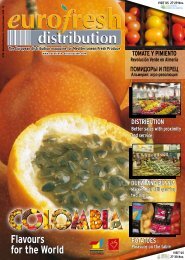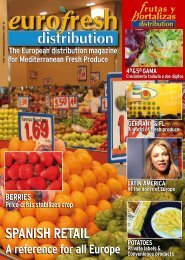You also want an ePaper? Increase the reach of your titles
YUMPU automatically turns print PDFs into web optimized ePapers that Google loves.
ApRIl EUROFRESH<br />
MAY<br />
meloN/melóN 2 0 0 7 DISTRIBUTION <strong>89</strong><br />
Piel de Sapo Cantaloupe<br />
sales continue to rise<br />
The consumption of the Piel de Sapo and Cantaloupe melon varieties<br />
continues to increase in the UK.<br />
According to data from TNS, the British<br />
market has over the last year (until<br />
the 22 of April of 2007) absorbed a total<br />
of 132.7 million melons and watermelons,<br />
with a value of 111.4 million<br />
pounds, which signifies a fall of 1% in<br />
volume with respect to the same period<br />
of the previous year, but with an<br />
increase of 7% in prices.<br />
Nevertheless and with regards to the<br />
different types of product, behaviour<br />
has been very different. For example,<br />
the greatest increase in sales are accounted<br />
for by the Piel de Sapo melon<br />
of Spanish origin, with an increase<br />
of +21% in relation to the preceding<br />
campaign, followed by the Cantaloupe<br />
with +20% and watermelon +16%,<br />
with their corresponding increases<br />
also in value, concretely, +19%, +22%<br />
and +22%, respectively.<br />
Worse luck was to be had by melon varieties<br />
such as the Charentes, whose<br />
consumption descended by 33% for<br />
the same period causing a decrease<br />
of 39% in the total invoicing for this<br />
melon variety.<br />
185.000 Baby Watermelons<br />
It is also worth noting the market debut<br />
of the Baby Watermelon, which<br />
while its sales are still of little signifi-<br />
cance in terms of the overall market,<br />
is worth considering as it represents<br />
a recently introduced product. Well<br />
placed within consumer tendencies,<br />
the Baby Watermelon is obtaining<br />
remarkable success. Last year was<br />
the first campaign in which this type<br />
of watermelon was sold in British establishments,<br />
and up till 22nd of April<br />
185,000 units were sold for a value of<br />
121 million pounds.<br />
Nevertheless most popular varieties<br />
continue to be the Honeydew / yellow<br />
which monopolize half of the market,<br />
even though their consumption fell by<br />
9% (+5% in value).<br />
Anecoop, 15 years of “Bouquet”<br />
seedless watermelons<br />
Created integrally by Anecoop from<br />
seed to crop, post-harvest and packing,<br />
“Bouquet” watermelons have<br />
achieved huge success over the last<br />
15 years. Millions of kilos of this fruit<br />
have been grown and marketed since<br />
1986, making it the star of all watermelons<br />
on the market today. Its key<br />
differentiators are its excellent taste,<br />
its deep red seedless pulp, and its<br />
light green outer colour with dark<br />
stripes that clearly distinguish it from<br />
traditional watermelons, reaping<br />
excellent results for both exporters<br />
and growers. Combining different<br />
growing areas has enabled the marketing<br />
season to be prolonged while<br />
maintaining the same brand and the<br />
same production and quality control<br />
criteria. All this extensive work has<br />
ranked Anecoop Bouquet watermelons<br />
as market leaders. The innovative<br />
range has gradually been expanded<br />
over the last fifteen years with specific<br />
varieties, and with greenhouses<br />
and farms referenced with growing,<br />
harvesting, post-harvest and packing<br />
specifications. Image has proved fundamental,<br />
together with a successful<br />
communication and promotion plan.<br />
In 2006, Anecoop marketed 63,000<br />
tonnes, and in 2007 expects to reach<br />
70,000 as production in the northern<br />
hemisphere lasts from mid-April to<br />
the end of October.<br />
El Grupo Fashion seedless<br />
specialist<br />
Fashion seedless watermelons variety<br />
represents more than half of El Grupo<br />
cooperative (Tropical coast of Spain).<br />
After harvesting 8000 tons last year,<br />
reverse climatic effects this season<br />
will bring down crop to 7000 tons. Following<br />
a strong market success last<br />
year, Fashion variety is been promoted<br />
directly toward the consumer this season.<br />
Main superior eating qualities<br />
promoted are a minimum of a 10ºBrix<br />
sugar content, as well as a quality certification<br />
at origin.<br />
El Grupo offers also a large variety of<br />
green-house vegetales, firstly tomato<br />
and Dutch cucumber, both under UNE<br />
155.000, ISO and BRC certifications.<br />
UK Melon consumption (2006-07)<br />
volumen valor<br />
Cantaloup/Cantalupo 10% 17%<br />
Charentes 1% 2%<br />
Galia 1 % 27%<br />
Honeydew/Amarillo 1% 1%<br />
Watermelon/Sandía 1 % 9%<br />
Piel de Sapo 3% 2%<br />
Other/Otros 2% 2%<br />
Source: TNS




